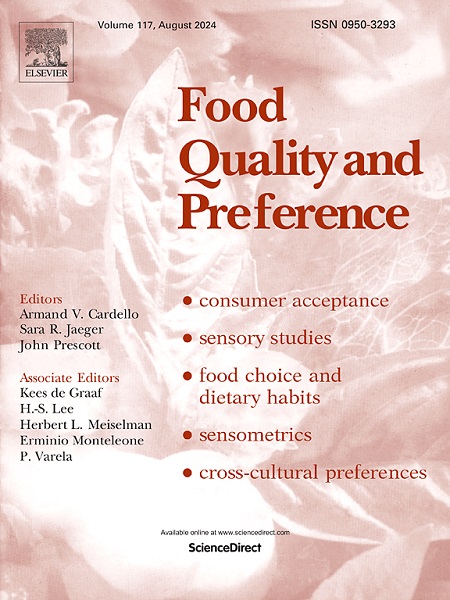Decoding the Taste Puzzle: Toward a better understanding of taste profiling
IF 4.9
1区 农林科学
Q1 FOOD SCIENCE & TECHNOLOGY
引用次数: 0
Abstract
Personalizing a diet based on individual taste preferences can lead to healthier dietary habits. However, the lack of comprehensive data on meal taste profiles limits effective personalization. To address this gap, our study employed both a survey study and a tasting trial to gather a detailed taste profile of 18 expert-designed recipes. A total of 2046 participants (55.5% female, mean age of ) in the survey, and in the tasting trial, 48 participants (83.3% female, mean age of ) provided insights into their taste perception, their familiarity with meals and overall liking. Our data revealed a substantial variability in survey responses, suggesting relying solely on survey data may not yield sufficiently accurate data to predict the taste profile of meals. Among all tastes, sweetness emerged as the most precisely predictable taste, whereas bitter taste posed significant challenges. Comparative analysis using a linear mixed model showed that ingredient-based data is comparable to or slightly better predictor of the taste profile than the survey, except for sweetness. Furthermore, hierarchical analysis underscored the critical role of taste interactions in enhancing the model fit. Future research should aim to collect more comprehensive data, encompassing a greater variety of meals to cover broader taste and trigeminal profiles. Our study sets the groundwork for more sophisticated predictive modeling for dietary customization.
解码味觉之谜:更好地理解味觉特征
基于个人口味偏好的个性化饮食可以带来更健康的饮食习惯。然而,缺乏全面的数据,膳食口味概况限制了有效的个性化。为了解决这一差距,我们的研究采用了调查研究和品尝试验两种方法,收集了18种专家设计的食谱的详细味道概况。调查中共有2046名参与者(55.5%为女性,平均年龄47.4±13.4岁),在品尝试验中,48名参与者(83.3%为女性,平均年龄37.6±14.5岁)提供了他们的味觉、对食物的熟悉程度和总体喜欢程度的见解。我们的数据揭示了调查结果的巨大差异,这表明仅仅依靠调查数据可能无法产生足够准确的数据来预测食物的味道。在所有的味道中,甜味是最准确预测的味道,而苦味则构成了重大挑战。使用线性混合模型的比较分析表明,除了甜度之外,基于成分的数据与调查结果相当,或者稍微更好地预测了味道。此外,层次分析强调了味觉相互作用在增强模型拟合中的关键作用。未来的研究应该旨在收集更全面的数据,包括更多种类的食物,以涵盖更广泛的口味和三叉神经。我们的研究为更复杂的饮食定制预测模型奠定了基础。
本文章由计算机程序翻译,如有差异,请以英文原文为准。
求助全文
约1分钟内获得全文
求助全文
来源期刊

Food Quality and Preference
工程技术-食品科技
CiteScore
10.40
自引率
15.10%
发文量
263
审稿时长
38 days
期刊介绍:
Food Quality and Preference is a journal devoted to sensory, consumer and behavioural research in food and non-food products. It publishes original research, critical reviews, and short communications in sensory and consumer science, and sensometrics. In addition, the journal publishes special invited issues on important timely topics and from relevant conferences. These are aimed at bridging the gap between research and application, bringing together authors and readers in consumer and market research, sensory science, sensometrics and sensory evaluation, nutrition and food choice, as well as food research, product development and sensory quality assurance. Submissions to Food Quality and Preference are limited to papers that include some form of human measurement; papers that are limited to physical/chemical measures or the routine application of sensory, consumer or econometric analysis will not be considered unless they specifically make a novel scientific contribution in line with the journal''s coverage as outlined below.
 求助内容:
求助内容: 应助结果提醒方式:
应助结果提醒方式:


